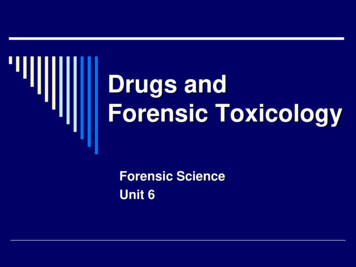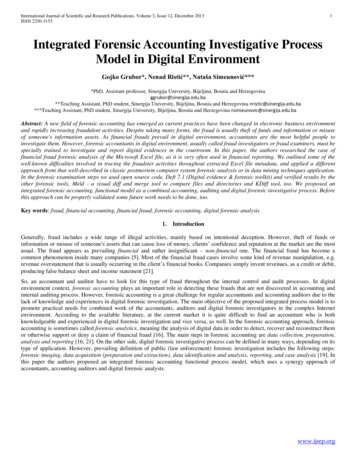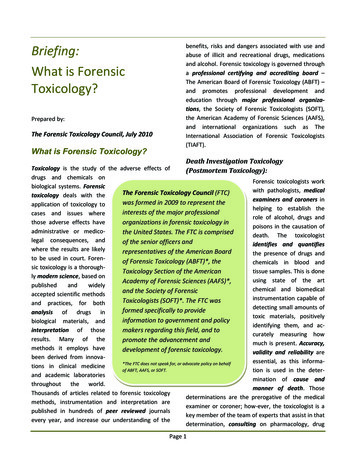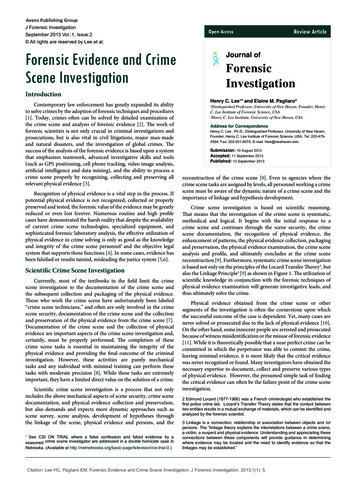
Transcription
Drugs andForensic ToxicologyForensic ScienceUnit 6
What is toxicology? Toxicology is the study of drugs andpoisons, and their interactions with oreffects on the body Forensic Toxicology is the applicationof toxicology to the law, including Workplace or Forensic Drug TestingPostmortem ToxicologyHuman Performance Testing
History of Toxicology Socrates was one of the earliestreported victims of poisoning, byhemlock, in 399 BC. By the 17th century, it was notuncommon for rich European families touse poisoning as a means of settlingdisputes. Arsenic became known as “inheritancepowder.”
History of Toxicology Mathieu Orfila (1787-1853) is consideredone of the fathers of toxicology as hehelped to develop a method of chemicalanalysis to identify arsenic and othertoxins in human tissue Today, less than 0.5% of all homicidesresult from poisoning
Toxicology Toxin: a substance that causes injury to thehealth of a living thing on contact or absorption,typically by interacting with enzymes andreceptors. Toxicologist: detects and identifies thepresence of drugs and poisons in body fluids,tissues, and organs Legal Institutions: crime laboratories and medicalexaminer’s officeHospital laboratories
What is a toxin? Properties that affect the toxicity DosageThe chemical or physical form of the substanceHow it enters the bodyThe body weight and physiological conditions of thevictim including age and sexTime of the exposureInteraction of the toxin with other chemicals present inthe body or the dose
Types of toxicity Chronic exposure: continuing exposure to toxinsover a long period of time Acute toxicity: occurring almost immediately(hours or days) after an exposure Synergism: combined effect of substances thatexceeds the sum of their individual effects Alcohol and ValiumCannabis and LSDCodeine and Ibuprofen
Role of the Toxicologist Studies body fluid, tissue, and organs fordrugs and/or poisons Must detect, identify, quantify, and assesstoxicity May have extremely minute quantities to test May conduct postmortem pathologicalexaminations, and examination of personaleffects and empty containers, etc.
Where can a Toxicologist work? Postmortem: Medical examiner or coroner Criminal: Motor Vehicle Accidents (MVA) Workplace: Drug testing Sports: Professional athlete (human andanimal) drug testing Environment: Industrial toxins, biological andchemical warfare
Collecting ToxicologicalEvidence When possible, collect both blood andurine Collect two voids (samples) of urinein separate specimen containers Collect a sample of blood if aphysician or registered nurse (RN) isavailable
ALCOHOL
Toxicology of Alcohol Alcoholic beverages contain ethanol,also called ethyl alcohol, which isobtained by the fermentation of sugarsfrom grains, fruits, and vegetables. Alcohol is a depressant, a chemical thatslows the heart rate and brain activity,and causes drowsiness
Alcohol Metabolism Alcohol is absorbed through the walls of thestomach and small intestine, and distributed byblood throughout the body. In the liver, the enzyme alcohol dehydrogenase(ADH) breaks down ethanol into acetylaldehyde(causes hangovers), then eventually into carbondioxide and water. The liver can normally metabolize 1-2 drinks (15-30mL or up to 1 ounce) an hour. When a persondrinks more than the liver can metabolize, theexcess is distributed to the tissues of the bodywhich can damage them.
Alcohol Absorption and Evaporation Alcohol gets absorbed from the stomach and intestinesinto the bloodstream. Alcohol is not chemically changed in the bloodstream. As the blood goes through the lungs, some of thealcohol moves across the membranes of the lung's airsacs into the air, because alcohol will evaporate from asolution. The concentration of the alcohol in the lungs is relatedto the concentration of the alcohol in the blood with aratio of 1 to 2100. It can be detected by breath alcohol testing devices,such as a Breathalyzer.
Rate of Absorption What affects the rate of absorption? Total time to consume the drinkAlcohol content in the beverageAmount of alcohol consumedQuantity and type of food present in the stomach Maximum blood-alcohol concentration May take as long as 2-3 hoursNormal social drinking conditions: 30-90 minutesfrom time of final drink
How is the alcohol eliminated? Elimination rate can vary up to 30% betweenindividuals Average is 0.015% w/v (15 mg of alcohol per 100 mL ofblood Oxidation: 95-98% of alcohol consumed isoxidized to carbon dioxide and water in the liveralcohol acetaldehyde acetic acid CO2 and H2O Reduction: remaining portion excretedunchanged in breath, urine, and perspiration Amount of alcohol exhaled in breath is in directproportion to the concentration of alcohol in blood
Movement of alcohol in the body1.Alcohol is ingested; moves down the esophagusto the stomacha.2.3.Alcohol is carried in the blood stream through theliver and then to the heartBlood enters the right atrium, then goes to theright ventriclea.4.5.20% moves through the stomach wall to the blood stream; theremaining alcohol passes through the walls of the smallintestineAt this point there is alcohol and CO2 in the blood; very little O2Blood goes to the lungs via the pulmonary arteryto be replenished with O2Rapid exchange of gases by breathinga.Oxygen for CO2 and alcohol
Henry’s LawDefinition: When a volatile chemical (alcohol) isdissolved in a liquid (blood) and is brought toequilibrium with air, there is a fixed ratiobetween the concentration of the volatilecompound (alcohol) in the air and itsconcentration in the liquid (blood), and this ratiois constant for a given temperature.
Blood Alcohol Content(BAC)BACmale 0.071 * (vol. consumed, oz.) * (% alcohol)Body weightBACfemale 0.085 * (vol. consumed, oz.) * (% alcohol)Body weight
Arterial versus Venous BAC Arterial blood-alcohol level is 41% higher than yourvenous blood 30 minutes after the last drink Breath test reflects the alcohol concentration in thepulmonary arteryBlood is drawn from the vein during a blood testBlood tests reflect the alcohol concentration in thebrain and therefore better indicate the impairment ofthe individualAt the end of the absorption phase, alcohol is evenlydistributed and both tests should show minimaldifference
Toxicology of Alcohol Approximately 40% of traffic deaths inthe U.S. are alcohol-related (2008) Toxicologists have had to developspecific procedures for measuring thedegree of alcohol intoxication Methods for diagnosis must bedefendable within the framework of thelegal system
Alcohol in the Blood Blood Alcohol Content (BAC) is usuallywritten as a decimal Example: 0.08This means there are 8 g of alcohol per10,000 mL of blood; your blood is 0.08%alcohol.Effects of Alcohol at Different BACs0.03 – 0.120.25 – 0.400.35 – 0.500.40 and upeuphoriavomiting, lossof bladdercontrolcirculatory andrespiratorysystemimpairmentcoma anddeath
Field Sobriety Tests If a police officer smells alcohol on adriver, he/she may perform fieldsobriety tests, including: Horizontal gaze nystagmus (HGN) test Nystagmusis involuntary jerkingmovements of the eyes; more pronouncedwhen intoxicated Walk and turn Heelto toe in a straight line, followingdirections One leg stand Countaloud by 1000’s for 30 secondsor recite alphabet backwards
Types of Testing Devices Two breath testing technologies are most prevalent. Desktop analyzers generally use infraredspectrophotometer technology, electrochemical fuelcell technology, or a combination of the two. Hand-held field testing devices are generally basedon electrochemical platinum fuel cell analysis and,depending upon jurisdiction, may be used byofficers in the field as a form of "field sobriety test"or as evidential devices in point of arrest testing.
Alcohol Breath Test 90% of alcohol is processed by the liver.The remaining 10% is excreted throughbreath, perspiration, and urine A breath test, such as a Breathalyzermeasures the amount of alcohol inexhaled air. The amount of alcohol in breath is1/2100 the amount in blood. 2100 mL of air has the same amount ofalcohol as 1 mL of blood.
Negative Effects of Alcohol All alcohols are toxic to the body. Consumption of alcohol can lead to liverdamage, possibly cirrhosis. Chronic alcoholabuse can lead to Korsakoff’s Syndrome. Driving while intoxicated can have deadlyresults. Alcohol may change the effect ofmedications. Never consume alcohol while taking drugs with asedative effect.
BAC and the Law A BAC greater than 0.08 is considered to be“drunk driving” Implied consent says drivers who receive adriver's license are automatically consentingto be tested for blood alcohol content if apolice officer has probable cause While a driver can refuse to take this test,implied consent laws often automaticallyrevoke licenses on the spot.
Factors Affecting Blood AlcoholTests Drinking on empty stomach (faster metabolism) Drinking with a fever (false positive) Using mouthwash or breath spray (falsepositives) No good way to spoof the systems.
Alcohol and the Law Schmerber v. California (1966): while beingtreated for injuries during a car accident,Schmerber was charged with DUI and blood wastaken. Supreme Court ruled that the Fifth Amendment onlyprohibits giving testimonial evidence that is selfincriminating, not physical evidenceAlso Schmerber was not subjected to unreasonablesearch and seizure since it was an emergencysituation. DUI is an emergency situation since thebody naturally eliminates the alcohol over time.
DRUGS
Drug use in the USA In 2010, 22.6 million Americans 12 or older (8.9 % of thepopulation) were current illicit drug users. This was anincrease over previous years, mostly due to moremarijuana use. Drug overdoses and brain damage linked to long-termdrug abuse killed an estimated 37,485 people in 2009,surpassing the toll of traffic accidents by 1,201. Many of these fatalities were due to prescription drugabuse.Source: http://www.cdc.gov/nchs/data/nvsr/nvsr59/nvsr59 04.pdf
Drugs “Drug” can mean different things Illicit or illegal drugs that have noaccepted medical use in the US Controlled substances: legal drugswhose sale, possession, and use arerestricted because of their effects and thepotential for abuse. Drugs can fall into one of severaldifferent classes: narcotics,hallucinogens, depressants, stimulants,club drugs, and steroids
Classification of Illicit Drugs Classified by Origin Naturally occurring substancesDerived from a naturally occurring substance (semisynthetic)Synthetic Classified by Major Effect on Humans StimulantsDepressantsHallucinogensNarcotics
Types of Drugs: Narcotics Narcotics reduce pain by suppressingthe central nervous systems ability torelay pain messages to the brain Pain relievers are called analgesics Narcotics induce sleep and depressesvital body functions such as bloodpressure, pulse, and breathing
Types of Drugs: Narcotics Varieties of narcotics: Opiates: derived from the Asian Poppy Herione, morhpine, codeineSynthetic opiates: man-made Methadone:given to heroine addicts to try andbreak their addiction Oxycodone (OxyContin or Percocet) Hydrocodone (Vicodin) Overdose on narcotics can result indifficulty breathing, low blood pressure,loss of consciousness, and possiblycoma and death.
Types of Drugs: Hallucinogens Hallucinogens alter the user’sperceptions, thinking, self-awareness,and emotions. Some hallucinogens can cause panicattacks, seizures, headaches, andsometimes psychosis that can last forweeks. Many hallucinogens, particularly PCP,increase the user’s heart rate, whichcould lead to heart failure.
Types Of Drugs: Hallucinogens Varieties of Hallucinogens Marijuana (from cannabis plant) Themost widely used illicit drug in the U.S. Contains tetrahydrocannabinol (THC) Has medical uses such as treating glaucomaand relieving nausea due to chemotherapy MDMA (“Ecstacy”)Mescaline (from Peyote cactus)LSD (Lysergic Acid, or simply “Acid”)PCP (phencyclidine or “Angel Dust”)Mushrooms (contain psilocybin)
Types of Drugs: Depressants Depressants are used to relieve anxietyand produce sleep. Depressants reduce body functions suchas heart rate. Overdose can cause coma and death. Mixing depressants with other drugs oralcohol can increase their effects andhealth risks.
Types Of Drugs: Depressants Varieties of Depressants: AlcoholBarbiturates: “downers” such asPhenobarbital and Methaqualone (alsocalled Quaaludes, illegal)Anti-psychotic and anti-anxiety drugsincluding benzodiazepines such asDiazepam (Valium)Inhalants (“huffing”)Sedatives, muscle relaxers, etc.Marijuana and opiates (like morphine) arealso considered depressants.
Types of Drugs: Stimulants Stimulants increase feelings of energyand alertness while suppressing fatigueand appetite. Also called “uppers.” Depression often results as the drugwears off. Stimulants are highly addictive. Overdose can result in irregular heartbeat, heart attack, stroke, seizures,coma, and death.
Types of Drugs: Stimulants Varieties of Stimulants Amphetamines, also called “speed.”Cocaine, including crack cocaine Derivedfrom the South American coca plant Addictions to cocaine are very difficult toovercome Methamphetamines, also called “meth.” Typicallymethamphetamines are more potentand dangerous than amphetamines
Meth Addiction
Types of Drugs: “Club Drugs” Club drugs are called such becausethey are most often used at nightclubs,bars, and raves (all night dance parties) Varieties of Club Drugs” Methylenedioxymethamphetamine (akaMDMA or Ecstasy) Chronicuse can cause body systembreakdown, severe brain damage, memoryloss, and seizures Ketamine or “Special K” is an animalanesthetic used by veterinarians
Types of Drugs: “Club Drugs” Date Rape Drugs are called thatbecause they are often associated withdrug-facilitated sexual assault, rape, androbbery. These drugs can produce increasedlibido and depress the central nervoussystem, resulting in loss ofconsciousness and memory. Varieties include GHB and Rohypnol(also called “Roofies”)
Types of Drugs: AnabolicSteroids Anabolic Steroids promote cell division andtissue growth Athletes may take steroids to increase musclemass Anabolic steroids are chemically related totestosterone Side effects include liver malfunction, cancer,breast development in males, masculinizingeffects in females, diminished sex drive inmales, unpredictable moods (“roid rage”),personality changes, depression, hypertension,and high cholesterol
How are Illicit Drugs Controlled? Title 21 United States Code ControlledSubstance Act Section 801 Controlled substances are put into one of fiveschedules. Schedule I Heroin, LSD, MarijuanaSchedule II Cocaine and MethamphetamineSchedule III Anabolic steroids and Aspirin orTylenol with CodeineSchedule IV Darvon and Valium Schedule V OTC Cough Medicines with Codeine
How are Illicit Drugs Controlled? Title 21 United States Code ControlledSubstance Act Section 801 Controlled substances are put into one of fiveschedules. Schedule I Heroin, LSD, MarijuanaSchedule II Cocaine and MethamphetamineSchedule III Anabolic steroids and Aspirin orTylenol with CodeineSchedule IV Darvon and Valium Schedule V OTC Cough Medicines with Codeine
Be careful All of these drugs, even the legal ones,can have harmful side effects. Overdosecan be deadly. Assignment: Drug Brochures
Poisons!
Toxins and Poisons A poison is any substance that causesdisturbance to an organism More specifically, a toxin is poisonproduced naturally by an organism Examples: snake venom, poison ivy
Is it a poison? Arsenic Found in the foods we eat and the water we drinkMay have a positive affect on humans; arsenicdeficiency stunts growth in chickens, rats, pigs, andgoatsUsed to treat a rare form of cancerUsed as a poison to kill people Oxygen, Water, Aspirin, Alcohol, Food
Measuring Toxicity Lethal dose (LD50): theamount of substance thatkills half of the testpopulation within fourhours; it is measured inmilligrams (mg) ofsubstance per kilogram(kg) of body weight Estimating lethal dose inhumans is uncertain;measurements usuallycarried out in lab geons75Rats53
Toxicity Classes and DefinitionsLD50(rats, oral)Correlation to 150 lbadult humanToxicity 1 mg/kgA taste to a dropExtremely1 – 50 mg/kgA teaspoonHighly50 – 500 mg/kgAn ounceModerately500 – 5,000mg/kg5 – 15 g/kgA pintSlightlyA quartPractically nontoxic 15 g/kgMore than a quartRelatively harmless
Some Lethal DosesSubstancesSucroseLD50(rats, oral)mg/kg29,700Vitamin icmetal7,0604,2203,000SubstancesCaffeineLD50(rats, oral)mg/kg192Arsenic trioxide14.6ArsenicpentoxideSodium cyanide86.4Ricin0.020Botulin toxin0.000005763
Effect of Poisons on the BodyPoisonSymptomsLyeCharacteristic burns around mouthand lipsCarbon monoxideSulfuric AcidHydrochloric acidRed or bright pink patches on thechest and thighs; bright red lividityBlack vomitGreenish-brown vomitNitric AcidCyanideYellow vomitBurnt almond smellArsenic, mercuryPronounced diarrheaMethyl (wood) alcoholand rubbing alcoholNausea and vomiting,unconsciousness, and blindness
Intake of Poisons Poisons enter and affect the body indifferent ways: Ingestion (poisons are eaten) 90%of all poisonings involve childrenswallowing household products or medicine Inhaled Example: carbon monoxide, sarin nerve gasInjected Heroine Absorbed (through skin, eyes, or mucousmembranes) Poisonsumac
Poisons: Pesticides Pesticides are by definition poisons asthey are used to kill organisms thatthreaten plants such as food crops Example: DDT (for mosquitoes) These chemicals lead to an excess ofthe neurotransmitter acetylcholine Overdose can lead to muscle spasms,seizures, anxiety, rapid heartbeat,sweating, diarrhea, and at highconcentrations coma and death
Poisons: Heavy Metals Metal compounds can enter the body byingestion, inhalation, or absorptionthrough the skin or mucous membranes Metals are stored in soft body tissuesand damage organs Examples: LeadMercuryArsenicCyanideStrychnine
Poisons: Heavy Metals Arsenic Poisoning Within 30 minutes: abdominal pain, severenausea, vomiting and diarrhea, musclecramps, convulsions, kidney failure,delirium, and death. Cyanide Poisoning Can be fatal in 6-8 minutes.Signs of poisoning include weakness,confusion, coma, pink skin, and analmond-like odor.
Lead Poisoning Lead compounds are not highly poisonous Taste sweet Metallic lead is insoluble, but in acidic water and food, the lead canbecome slightly soluble Chronic exposure is a health problem for many Americansespecially children Brain damageAffects memory or thought processes Lead-based products 38 millions houses have lead-based paint (prominent until the late70s) Leaded gasoline (banned in 1995) still remains in soils Lead pipes (banned in 1986) in older houses and towns Solder joints in older houses Leaded crystal and ceramics
Carbon Monoxide Poisoning Carbon Monoxide (CO) binds with hemoglobin in red bloodcells and does not allow the cells to carry O2. Death byasphyxiation follows. CO saturation of 50-60% is considered fatal in middle-agedpeople In conjunction with a BAC of 0.20, CO saturation of 35-40% is fatalChain smokers normally have a CO saturation of 8-10% CO from automobile fumes is a common way to commitsuicide Enough CO accumulates in 5-10 minutes to cause death Death from fire or foul play High CO levels in victims of a fire is proof that the person was alivewhen the fire began and died from the combustion products of the fire
Poisons: Bioterrorism Agents A bioterrorism attack is the deliberaterelease of viruses, bacteria, toxins orother harmful agents used to causeillness or death in people, animals, orplants. Examples include: RicinAnthraxMustard Gas usedin World War I A man-made gas Forms large blisters on exposed skin and thelungs
Poisons: Bioterrorism Agents Ricin comes from castor beans. Can be inhaled as a mist or powder, oringested in foodAmount the size of a pin head can be deadly!Within a few hours of exposure the victimmay die Ifinhaled effects include fever, cough, nausea,sweating, low blood pressure, fluid in the lungs,and death If ingested effects include vomiting diarrhea,dehydration, low blood pressure, hallucinations,seizures, and death
Poisons: Bioterrorism Agents Anthrax poisoning is caused by the sporesof the bacteria Bacillus anthracis Anthrax can enter the body throughinhalation, ingestion, or skin absorption Symptoms depend on exposure type: Inhalation: flu-like symptoms that becomeprogressively worse and usually result indeath.Ingestion: vomiting, fever, abdominal pain,and severe diarrhea. 25 - 60% fatal.Skin: itchy bumps that develop into sores witha black center. Death is rare with appropriatetreatment.
Government Agencies thatRegulate Toxins The Food and Drug Administration (FDA):deals with pharmaceuticals, food additives, andmedical devices The Environmental Protection Agency (EPA):works on agricultural and industrial chemicalsreleased into the environment The Consumer Product Safety Commission:concerned with toxins in consumer products The Department of Transportation (DOT):watches over the shipment of toxic chemicals The Occupational Safety and HealthAdministration (OSHA): concerned withexposure to chemicals in the workplace
Warning Labels Material Safety DataSheets (MSDS) Chemical IdentityHealth Hazard DataManufacturer informationPrecautions for Safe Handlingand UseHazardous ingredientsExposure controls/personalprotectionPhysical and chemicalpropertiesFire and Explosion HazardData Transportation Placards Four digit number refers to thespecific chemical carried inside Class refers to the type ofchemical inside the vehicle Class 1 ExplosivesClass 2 Compressed GasesClass 3 Flammable LiquidsClass 4 Flammable SolidsClass 5 OxidizersClass 6 PoisonsClass 7 RadioactiveMaterialsClass 8 Corrosive Liquids
Drug Control Laws There are varying levels and penaltiesbased on: manufacture vs. distribution vs. possessiontype, amount, concentration
Controlled Substance Act The Controlled Substances Act – thefederal law that establishes fiveclassifications (“schedules”) of controlleddangerous substances on the basis of adrug’s potential abuse, potential forphysical and psychological dependence,and medical value The U.S. Attorney General has theauthority to add, delete, or reschedule adrug as needed
Controlled Substances ActSchedule I High potential for abuse no currently accepted medical use in theU.S. Examples: heroin, marijuana (somestates), methaqualone, LSD
Controlled Substances ActSchedule II High potential for abuse some accepted medical use with severerestrictions, potential for severe physiological andpsychological dependence Examples: morphine, cocaine, methadone,PCP, most amphetamine preparations,most barbiturate preparations, and medicalmarijuana (some states)
Controlled Substances ActSchedule III Less potential for abuse currently accepted medical use potential for low to moderatephysiological and high psychologicaldependence All barbiturates not included in ScheduleII, such as codeine preparations andanabolic steroids
Controlled Substances ActSchedule IV Low potential for abuse current medical use Examples: tranquilizers such ValiumSchedule V Low abuse medical use less potential for dependence than Schedule IV Examples: Robitussin cough syrup, nonnarcotic medicinal ingredients and some opiatedrug mixtures in low concentrations
Criminal Penalties Schedule I and II have the most severepenalties The Controlled Substance Act controlssubstances that are chemically similar orrelated to controlled substances such as“designer drugs” It also regulates the manufacture anddistribution of chemical compounds usedby clandestine labs to make drugs
Testing for Drugs
Color Tests Used for SCREENING ONLY Marquis Reagent- Purple forHeroin, morphine, and mostopiates, Orange-brown foramphetamine andmethamphetamine, Black forMDMA
Marquis Reagent
Dillie-Koppanyi Turns violet-blue in the presence ofbarbiturates
Duquenois-Levine Two step test for marijuana,results in a purple color
Scott Test Add cobalt thiocyanate turns blue in thepresence of cocaine and then pink whenHCl is added
Microcrystalline Tests This is a CONFIRMATION test, but notcommonly used in the lab too difficult, requires lots of training,drug must be extremely pure Based on the color and shape of crystalsformed when different reagents areadded
Microcrystalline Tests
Chromatography A physical method of separation Components partition between twophases Stationary phase—doesn’t move Mobile phase—does move Solutes are separated due todifferences in how they interact withthe two phases
The separation process Sample components are carried bya mobile phase through a bed ofstationary phase Individual substances are slowedby the stationary phase based onvarious interactions such as surface adsorption relative solubility charge
The separation processCompound A has a greater affinity for the stationary phasethan compound B and, therefore, will take longer to elute(that is, have a greater retention time).Mobile PhaseAA AAAAB BBB BBB BB BBStationary PhaseBATime
Thin layer chromatography(TLC) Stationary phase is solid coated ontosurface of glass Mobile phase is liquid or liquid solution Analyte is introduced as spot at bottomof TLC plate Mobile phase carries up plate bycapillary action Detection by UV or color spray
Diagram of TLC ExperimentSamplespotVery thin coatingof silica gel oraluminaRising solvent;original spot hasseparated intoseveral spots
TLC results
TLC results
Gas Chromatography Stationary phase is viscous liquid coated onto solid substrateMost stationary phases are capillarycolumnsMobile phase is an inert gas underpressure; usually nitrogen or heliumSubstances must be thermally stableMeasures retention time
Diagram of gaschromatograph
Chromatogram of Organic Compounds from FermentedCabbage
Chromatogram of Orange JuiceCompounds
Gas Chromatography Analyte is usually solid or liquid Liquids directly injected with syringe Solids are dissolved in solvent and theninjected Analyte is vaporized and mixed with mobilephase in injector Injector is heated to 25 degrees abovemaximum column temperature Usually micrograms of analyte are sufficient
Stationary phase Usually a thin walled capillary coatedwith viscous liquid. May be 3-60 meterslong Heated to 300 degrees C maximum The higher the temperature, the fasterthat substances will elute but fast elution rates mean poorerresolution Separation is based on mass action andpolarity
Separation of analytecomponents Mass action: heavier molecules travelmore slowly Polarity: stationary phase is polarrelative to mobile phase. Stationaryphase polarity is chosen to complimentpolarity of analyte components. Nonpolar analytes are better separated bynonpolar stationary phases
Detection of GC Peaks Detector must be able to detect changein vapor composition at microgram tonanogram level. Detectors enable bothquantitative and qualitative analysis Qualitative: retention time characteristicof substance but not dispositive Quantitative: Area under peak isproportional to amount of substancepresent
Gas Chromatography - MassSpectrometry Mass spectrometer is detector for GC GS separates components of mixture. Each component is sent to massspectrometer
Mass Spectrometry Mass spectrometer bombardsanalyte component with beam ofelectrons Molecule breaks apart into stable,reproducible fragment ions by loseof electron Pattern of fragments can ID themolecule
Spectroscopy SPECTRUM: series of colors, includingthose beyond the visible, produced bydispersion of radiated energy. SPECTROSCOPY (n): The branch ofscience dealing with the theory andinterpretation of spectra. It is the studyof the interaction of electromagneticradiation with the quantized energystates of matter.
Theory of Spectroscopy Spectroscopy is based upon thefact that there is a quantizedenergy transfer between radiationand matter The energy of light affected by thistransfer reveals information aboutthe structure and environment ofthe matter in question
Electromagnetic spectrum Gamma raysX-RaysGammaRaysVisibleUVMicrowaveIRRadio X-rays Ultraviolet Visible Infrared Microwave Radio10-1110-910-710-510-3Wavelength (cm)10-11010 3
Interactions of matter andlightIn forensic science, we are more concerned withwhat happens to a substance when it is exposedto light of much lower frequencies and energies.There are two principle regions of light that aremost important in characterizing evidenceUltraviolet/visible (UV/vis)Infrared (IR)
Ultraviolet light and matter All compounds have color They absorb more or less light of awavelengthWe only perceive color in the visible range400-800 nm Light appears uniform but is reallycomposed of many colors White light can be broken down into itscomponent colors with a prism
Roy G Biv
Pigments “make” the color Molecules absorb light ofspecific energy orwavelength Wavelength of lightabsorbed depend onelectronic structure ofmolecule Pigments and dyes of inkare designed to absorb invisible range
UV/Vis Spectrophotometry Measures the absorption of UV or visiblewavelengths of light and produces agraph called an absorption spectrum Not specific enough for 100%confirmation- some compounds withsimilar chemical structures will give verysim
What is toxicology? Toxicology is the study of drugs and poisons, and their interactions with or effects on the body Forensic Toxicology is the application of toxicology to the law, including Workplace or Forensic Dru










